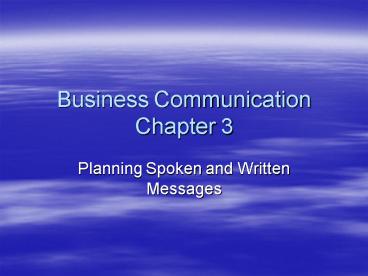Business Communication Chapter 3 - PowerPoint PPT Presentation
1 / 14
Title:
Business Communication Chapter 3
Description:
Studies have determined that one of three employees in corporate America writes ... connotative words and phrases that are nasty or imply other meanings in addition ... – PowerPoint PPT presentation
Number of Views:88
Avg rating:3.0/5.0
Title: Business Communication Chapter 3
1
Business CommunicationChapter 3
- Planning Spoken and Written Messages
2
Corporations Value Communication Capability
- Studies have determined that one of three
employees in corporate America writes poorly
companies invest more than 3 billion annually
trying to train them to write better. - Lets see what we can do to help you seize this
opportunity by being part of the apt majority
rather than the inept minority.
3
How To Prepare a Message
- What is the purpose of your communication? To
seek support? To inform? To entertain? To
persuade? To motivate? - What is the appropriate channel for your
communication? Written? Spoken? Electronic? - Who is the audience? What is their age, economic
level, education, occupation, culture? - What are the surrounding circumstances?
- What are the needs and concerns of the audience?
Beware your filters as you answer this question
because you must get out of your head and into
theirs before crafting your message. - Routinely taking this approach over time will
build trust with them. - Now you are ready to craft a clear, honest and
persuasive message!
4
Writing Process
- To make your audience feel important, take a
you, not an I/me approach. - Will the receiver(s) perceive your message as
prompt and fair? - Should you begin with a compliment? This can be
useful, but be careful of insincerity. - Is your communication truthful, honest and
ethical, avoiding embellishment and exaggeration?
Is your tone modest? Be conservative! - Is your message clear, logical and supported?
The sweat and selection necessary to write well
will force you to become a better thinker.
5
Writing Tips
- Most business writing adapts to a circular
approach - State
- Support
- Summarize
- SSS a circle
6
Writing Tips
- Research broadly and deeply.
- Ponder and analyze.
- Select a position (the first S) Based on my
research, I conclude. - Burst write to spill out the position and
supporting facts. Read what you have written. - Now pretend you are verbally explaining it to a
friend. Write down your spoken words. - Extract a lead sentence of no more than 30 words
summarizing your position.
7
Writing Tips
- Select supporting points explain each in a short
sentence and arrange them under the lead
statement in descending order of importance or
another naturally related sequence. - Write a final statement summarizing your entire
argument. - Write transitions smoothly connecting opening
statement, supporting points and summary
statement. Keep your words short, direct and
Anglo-Saxon! - Rewrite, polish and condense removing extra
words. - Do a final check of your and then-and then
logic chain. Is it persuasive? Does your
conclusion stand up? - Proofread for syntax, grammar, spelling and
punctuation. - Rewrite! Rewrite! Rewrite!
8
Now Re-assess Before Sending or Presenting
- Is what you have written
- Supported with objective facts?
- Researched broadly enough? Faulty assumptions
can lead the company astray and destroy your
personal credibility. - Undistorted by your personal filters?
- Tactfully expressed to avoid offending the
audience and harming the companys reputation
(avoid libel and slander and pay attention to
tone)? - Supported by honest graphics (does Mr. Picture
match Mr. Word?)
9
Writing Tips
- Avoid connotative words and phrases that are
nasty or imply other meanings in addition to
their denotative meaning. They can make your
message unclear or negative, generating reactions
you dont want. Example gripe session for
employee forum. Personal example I could use
some of this on my garden. - Be as specific as possible.
- Example complete the report by May 2 instead
of as soon as possible.
10
Writing Tips
- Avoid biased language. For example, gender bias.
- Each employee must submit his completed health
report. Oops! You just excluded 50 of the
population. - Each employee must submit a completed health
report. - waitress (server) foreman (supervisor)
- hostess (host) actress (actor)
11
Writing Tips
- Also be sensitive to age and ethnic-biased words
and phrases - Avoid outdated business expressions such as
pursuant to your request (as you requested)
enclosed please find (enclosed is) and other
dusty oddities. - Avoid cliches that undercut the sincere, genuine
tone you should be trying to achieve. - Avoid 50-cent Latin words when 10-cent
Anglo-Saxon ones will do. Terminate (end),
Procure (get) Remunerate (pay). Try to write
in a conversational tone. - Write concisely and economically I would have
written a shorter book if I had had time. Mark
Twain
12
Writing Tips
- Avoid redundancy exactly identical, past
history, cash money, progress forward, the
honest truth, pair of twins, personal
opinion, best ever, severe crisis, etc. - Use active, rather than passive, voice The
document was prepared by Tom -- Tom prepared
the document. - Use strong, direct, action-oriented verbs.
- Every time you want to use the word that, ask
yourself if you really need it. - KEY TECHNIQUE Is this word/phrase necessary?
Example She was a manager that was courteous.
She was a courteous manager. - If possible, call attention to the positive, not
the negative.
13
Effectively Sequencing Ideas
- Why are you writing the message and what is its
central idea? - What is the receivers likely reaction
positive, negative, neutral or uninterested? If
negative or uninterested, you may want to present
rationale first, building up to the central
message (inductive rather than deductive
sequencing).
14
Sequencing
- Time series of events or steps
- Space geographic areas
- Familiarity known to less known
- Importance order of importance
- Value order of monetary value































